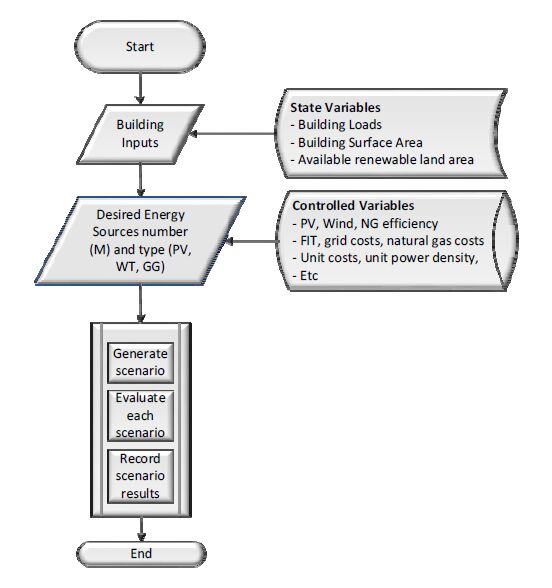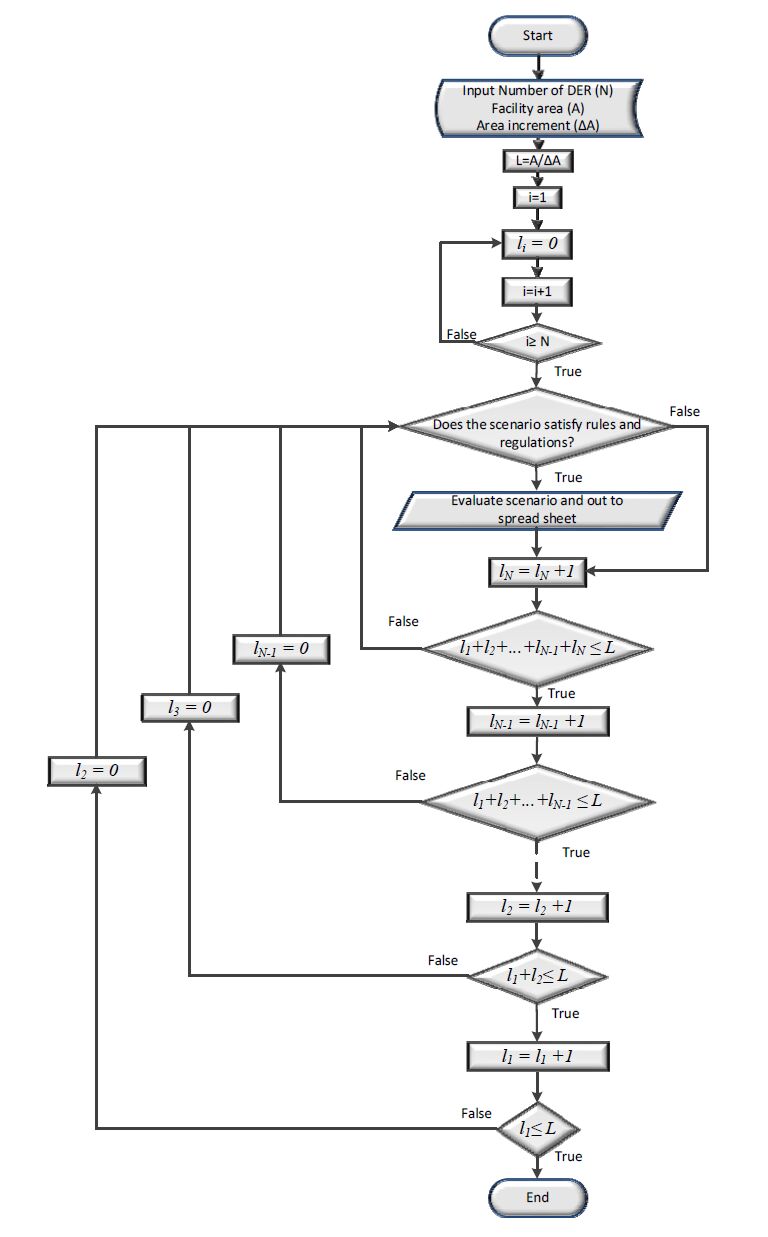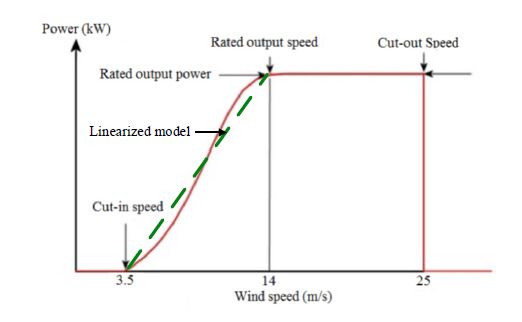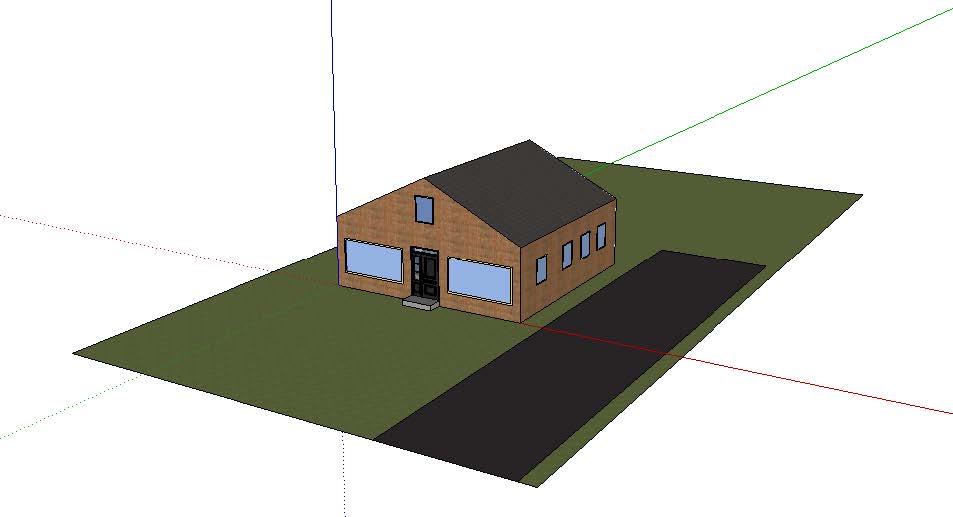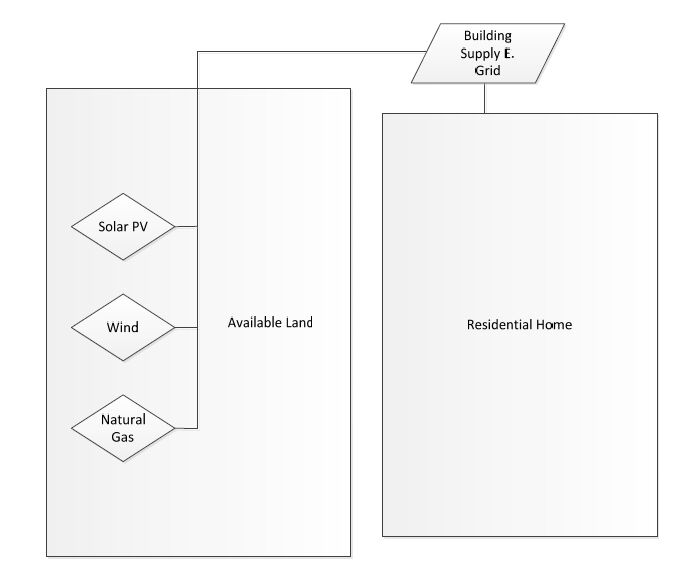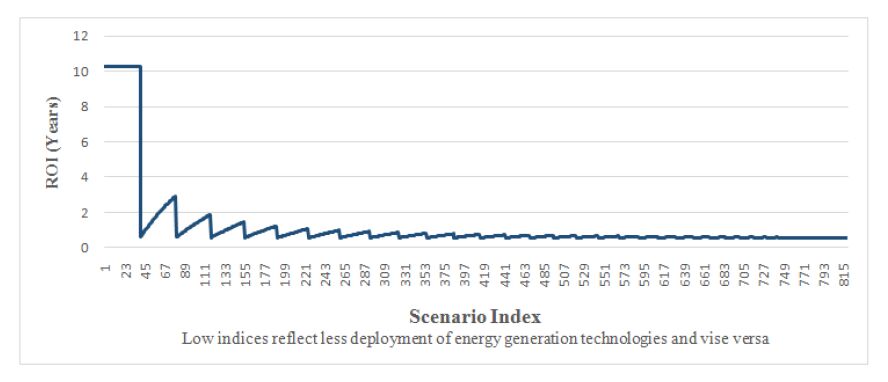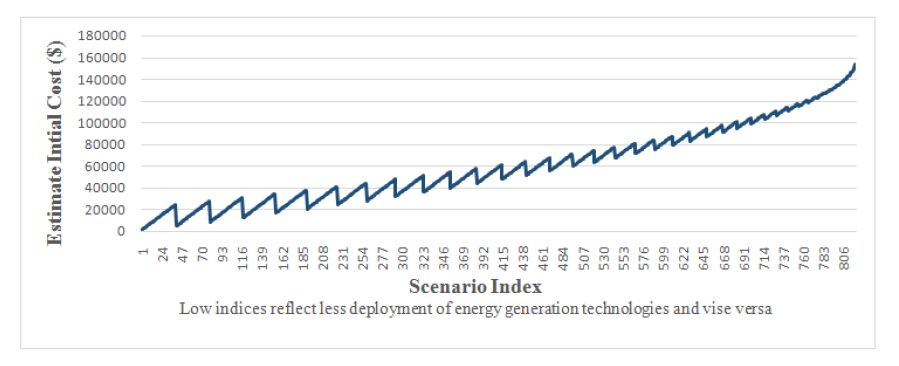Abbreviations
| BECM | Building Energy Conservation Management |
| DER | Distributed Energy Resources |
| EDSP | Energy Deployment Scenarios |
| ESN | Energy Semantic Network |
| FIT | Feed-In-Tariff |
| GG | Gas Generator |
| IEA | International Energy Agency |
| KPI | Key Performance Indicator |
| NG | Natural Gas Electric Power |
| PV | Photovoltaic Solar Power |
| RES | Renewable Energy Sources |
| ROI | Return On Investment |
| WT | Wind Turbine |
Symbols
| A | Facility area |
| △a | Minimum increment of area to install generator |
| Cop | Operational cost ($) |
| CsI, CwI, CgI | Initial (capital) cost of solar, wind and gas generators respectively ($) |
| CsIavg, CwIavg, CgIavg | Initial (capital) cost of solar, wind and gas generators respectively ($) |
| Es, Ew, Eg | Annual produced energy for solar, wind and gas generators respectively (kWh) |
| fu | Hourly consumed fuel profile (m3/h) |
| fuy | Yearly fuel consumption (m3) |
| k | Hourly sample index ranges from 1 to 8760 (number of hours per year) |
| ls, lw, lg | Normalized size with respect to incremental area∆a for solar, wind and gas generators respectively |
| M | Number of selected energy generators |
| N | Number of scenarios |
| Psavg, Pwavg, Pgavg | Average power generated from one square meter for solar, wind and gas generators respectively (watts) |
| Psr, Pwr, Pgr | Rated power for solar, wind and gas generators respectively (kW) |
| Ps, Pw, Pg | Generated power for solar, wind and gas generators respectively (kW) |
| rs | Solar irradiance profile (watt/m2) |
| vw | Wind Speed (m/s) |
1. Introduction
Energy consumption in buildings constitutes the largest share of total worldwide energy consumption (35%). That is one third of the total energy consumption, while industry sector (31%), Transportation sector (30%) and other sectors (4%) (Services, fishing, agriculture, forestry and non-specified) [1]. During 2013, residential sector in Canada had an energy demand of 1635 PJ which represented 13% of total Canadian energy demand [2]. Hence, attempts to reduce energy consumption in residential sector will significantly reduce global energy consumption and improve its economic and environmental impacts. Building energy conservation is an active and growing research discipline that guides engineers to design and modify buildings to reduce their consumption [3]. Major activities have been recorded to apply energy conservation measures in building to reduce the consumed energy for heating [4,5,6,7]. This is due to the significance of energy consumed for thermal comfort and climate control, which represents about 60% of total consumed energy in buildings [8]. There are number of simulation tools such as Energy-Plus that facilitate heat models and simulations for buildings. There are others that combine both Energy Conservation Building Code (ECBC) and advance Energy Efficiency Measures (EEMs) that lead to up to 61.75% savings in energy consumption [9,10]. Other effective procedures of building energy reduction have been identified for the deployment of distributed energy sources. Accordingly, building will be able to generate a large share of the energy required, and also reduce energy losses associated with long distance power lines. Further research efforts are exerted in the area of net-zero or zero energy buildings to reduce total energy consumption [11,12,13].
Buildings with complex structures and energy profiles require methodology for creating potential deployment scenarios of Distributed Energy Resources (DER) with effective validation and evaluation capabilities. Such methodology will provide clear view of different alternatives that can be implemented to generate and distribute energy within buildings. Energy simulation tools, such as HOMER [14] and EnergyPlus [15], are examples of software used to evaluate different energy conservation scenarios of buildings.
In [16], authors proposed an algorithm, called GreenCharge, to manage renewable energy and storage in buildings. Their effort is to determine charging and discharging profiles for battery banks to support energy demand and energy harvesting periods. Another effort was conducted to implement solar windows in residential buildings [17]. In previous works [11,12,13,16,17], no systematic methodology was able to generate all possible scenarios of energy deployment or conservation.
The proposed methodology allows simulation and evaluation of multiple scenarios for the deployment of energy sources in buildings. The results of the simulation and evaluation are exported to a spreadsheet such that it can be easily accessed and analyzed using other available tools. The proposed algorithm accepts basic information regarding the building type and structures, and generates possible scenarios using an energy knowledge database in view of energy semantic networks (ESN). Energy knowledge database contains environmental and economic information such as local irradiance profiles, wind speed profiles, (Feed-In-Tariff) FIT costs, electricity costs, natural gas costs, etc. According to building systems, the algorithm generates all possible scenarios for DER structures, and analyzes deployment and performance evaluation results for all generated scenarios. Based on the evaluation of different alternative energy scenarios, the selection of effective energy solution can be achieved according to the desired performance.
2. Algorithm Overview
Energy Deployment Scenarios Program (EDSP) is an algorithm that is based on Energy Semantic Network (ESN), which is proposed for Building Energy Conservation Management (BECM). The structure of ESN was presented in [18], where it includes energy domain knowledge with rule-based reasoning to support decisions related to building energy system design and operation. A dynamic knowledge structure of ESN was used for energy production chain assessment. The knowledgebase of ESN covers model libraries of building envelop components and energy technologies. It contains classes of building types, sizes, thermal zones, energy sources, energy conversion and energy storage. Each class encompasses information about energy components and related parameters. Based on the selection of building type and size, ESN static structure is synthesized as energy supply-production paths from generation to loads, including storage. The static ESN structure is unitized by EDSP to generate detailed scenarios with evaluation capabilities using selected key performance indicators (KPIs). The following section will provide description of ESN. Sections 2.2 and 2.3 discuss the proposed EDSP algorithm.
2.1. Energy Semantic Network
Energy semantic network (ESN) is a network that describes the relationships among different energy generation and load classes as per supply, storage, and utilization scenarios. ESN classifies building energy types as: electric, thermal, or gas. Building energy classes includes: thermal zones, loads, storage, and energy sources. All energy requirements are recognized and associate with these classes. The semantic connections among energy classes represent all possible energy scenarios. It can be considered a mapping tool between problem domain that describes building requirements and capabilities and design domain that describes possible energy scenarios. ESN model was developed by the authors in [19].
Figure 1 shows a simplified ESN for buildings. The building is broken down based on its classification (Residential, Commercial, Industrial), which is further broken down into sub-classes. Within each sub-class, and according to ESN knowledgebase, the building can be broken down into zones and available areas for DERs deployment. ESN provides generic structure of energy system within the building. The EDSP unitizes the generic structure to generate detailed scenarios with evaluation tool using predefined KPIs such as economic, environmental and reliability, and quality KPIs [20]. ESN allows the implementation of restriction rules to limit generated scenarios to feasible ones only.
2.2. EDSP Architecture
EDSP Algorithm architecture is shown in Figure 2. The algorithm starts by receiving inputs about building information such as building type, monthly building loads (kWh and cost) and building systems/facilities (available area for energy generation deployment). The input data can either be supplied by user, in case of specific building with available data, or using generic model created by ESN. Then, user selects energy sources that are desired to be deployed and how they will be applied (FIT or microFIT [21]).
Based on the inputs, EDSP generates spreadsheet of all possible energy scenarios. For each scenario rule-based limitations or constraints are applied. Those constraints describe the governing regulations and rules for building and energy that may affect the design of relevant energy systems. Only scenarios that satisfy the specified constraints in the rule-base are subject to evaluation. The results of the evaluation process are exported to a spreadsheet for analysis and selection process. The output data of the EDSP represents KPIs values, which are selected for further evaluation. The designer can select from the different alternative scenarios based on KPIs values.
2.3. EDSP Scenario generation Sub-Processes
Energy scenario synthesis is conducted based on three types of DERs: PV, wind turbine and gas generator. Figure 3 shows the flowchart of EDSP scenario generation sub-process. The algorithm is structured based on nested loops to create energy source deployment scenarios, which are further evaluated using KPI analysis. The algorithm outer loop start by assigning portion of building systems/facilities for one energy generation technology. Then the algorithm increments the size of other generation technologies in inner loops so that the total area used by energy generation is less than the area of building facility. For each case, the algorithm performs KPIs analysis and stores results in a spreadsheet. The outer loop increments the first generation size and processed with the inner loops to generate more scenarios.
The number of generated scenarios is given by:
where N is the number of possible scenarios, M is the number of selected energy generators and L is the given by:
where A is the facility area of the building and is the minimum increment of area to install the generator.
Figure (4) shows an example of generated scenarios assuming two DER (M=2) and area of building facility A m2 and minimum increment (Δa) of 1 m2.
EDSP program will create spreadsheet with array of a length equal to number of scenarios and row width equal to number KPIs required for the evaluation process.
2.4. Algorithm parameters
This section lists energy technology parameters required for the evaluation and analysis process of scenarios synthesis. Table 1 shows classification parameters that are used for KPI evaluation and analysis using the proposed algorithm. It should be noted that those parameters are kept unchanged for all the created scenarios for a single case study, so that all scenarios are evaluated on the same basis of KPIs. For different case study, some or all of the listed parameters are subject to adjustment depending on geographical location, for example solar irradiance, or might vary depending on governmental regulations (FIT and electricity grid prices).
Table 1.Classification of State variables.
| Classification | Technology/Other | Parameters |
| Electrical Energy | Solar | - Average unit power |
| | - Average unit cost |
| | - Capacity factor |
| | - Inverter efficiency |
| Electrical Energy | Wind Turbine | - Average unit power |
| | - Average unit cost |
| | - Capacity factor |
| | - Mechanical efficiency |
| | - Inverter efficiency |
| Electrical Energy | Natural Gas Generator | - Average unit power |
| | - Average unit cost |
| | - Mechanical efficiency |
| | - Inverter efficiency |
| | - Fuel consumption rate |
| Electrical Energy | Grid | - Grid costs of electricity |
| | - FIT costs (per source) |
| | - microFIT costs (per source) |
| | -FIT power ratings |
| | - microFIT ratings |
| Gas Energy | Grid | - Grid costs (volumetric costs rates) |
| Potential Energies | Location based | - Average local solar irradiation |
| | - Average local wind speed |
The average power of the three energy technologies: PV, wind turbine and gas generator, are the parameters subject to change during scenario creation. Each scenario assumes unique settings for the size of the power of the combined PV, wind turbine and gas generator.
2.5. Code Assumptions
The algorithm is designed to generate possible deployment and interconnection scenarios for generic buildings. However, some assumptions have been made to achieve feasible evaluation criteria of different scenarios. The assumptions used for the algorithm are:
1- Average unit costs are used to give a fair estimate of the overall costs.
2- Despite the fact that each energy generator size to power ratio is different, the area assigned to unit power of each generator is the same. This is because the technology that requires more operational space, such as PV, requires less service and safety zone compared to gas generator that requires less operational space and more service and safety zone.
3- Solar and Wind history data are valid for algorithm evaluation assuming they are white Gaussian random variables.
4- All generation technologies produce their maximum output power according to their rating and the relevant wind and irradiance profiles.
5- Using Efficiency factors for various technologies (inverter, transformers, etc.)[22,23].
6- Wind and irradiance directions are perpendicular to wind turbine and PV cells, respectively.
2.6. Rule-Based
It is common practice that the number of scenarios grow exponentially with the increase of problem dimensions (facility size, number of energy generation technologies, and number of loads). Hence, a computational difficulties could be examined during the evaluation and analysis of different scenarios even with the presence of powerful computational processors available today. In order to mitigate this problem, a rule-based restriction was applied in order to reduce number of created scenarios and consequently, reduce the computational complexity and response time. The rule-base represents local laws and regulations applied to power system and building structure. Accordingly, options were created to restrict users to select FIT (Feed-In-Tariff) and microFIT. The FIT program ranges from 10 kW up to 500 kW while the microFIT ranges from 0-10 kW. The user selects one deployment option (FIT or microFIT) and consequently, the algorithm applies restrictions encoded in the rule-base to create possible scenarios.
In addition, building types significantly affect the type of energy generation technology to be used. For example, residential buildings such as townhomes, apartment blocks, and homes cannot apply the same wind turbines used for agricultural farm. Thus, the algorithm adjust the incremental step size to match building type. With these rules in place, effective overall scenario creation is achieved with minimum number of created scenarios. This improves the response time of the execution of the proposed algorithm.
2.7. Algorithm KPIs used for evaluation process
2.7.1. Solar PV Generation (kWh)
The size of the solar PV generator is given by:
|
Psr=ls×Δa×Psavg/1000kW
|
(3)
|
where Psr is the rated power of the PV, ls is the normalized size of the PV with respect to incremental area Δa and Psavg is the average power (watts) generated by one square meter of available PV panels in the market. The annual generated energy using PV is given by:
|
Es=8760∑k=1ls×Δa×ηsavg×rs(k)/1000kWh
|
(4)
|
where ηsavg is the average efficiency of available PV panels in the market, rs(k) is the irradiance profile (watt/m2) for the hour k and the summation is conducted for one year.
2.7.2. Wind Generation (kWh)
The wind power is given by:
|
Pwind=1/2×ρ×lw×Δa×v3w/1000kW
|
(5)
|
Where ρ is the airdensity (nearly 1.225 kg/m2, A is the rotor swept area (A=πr2), lw is the normalized size of the wind generation with respect to incremental area Δa and vw is the air velocity (m/s). Hence, the wind power at wind velocity of 14 m/s crossing one square meter is 1.67 kW. The relation between wind power and wind turbine output power is given by:
where 16/27 is Betz limit and μT is Turbine efficiency. Turbine efficiency was set to 30% [24] hence, at wind velocity 14 m/s, the wind turbine can generate peak power of 504 W/m2.
The wind turbine output power is based on wind power trend shown in Figure 5 [24,25,26]. According to the trend shown in Figure 5, the output power of wind turbine is given by:
|
Pw(k)={0vw(k)≤3.5Pwr11.5(vw(k)−3.5)3.5≤vw(k)≤14Pwrvw(k)≥14
|
(7)
|
The annual energy generated by wind turbine is given by:
where vw(k) is the wind speed profile (m/s).
2.7.3. Natural Gas Generation (kWh)
The gas generator is assumed to be working with its rating capacity during the year. It is assumed that the surplus generated energy of all generators is exported to the utility grid using FIT or microFIT program. The rated power of the gas generator is given by:
|
Pgr=lg×Δa×Pgavg/1000kW
|
(9)
|
Hence, the annual generated energy by the gas generator is given by:
where Pgr is the rated power of the gas generator, lg is the normalized size of the wind generator with respect to incremental area Δa and Pgavg is the average gas power in watts that can be generated from gas generator occupying one square meter.
2.7.4. Initial Costs
The initial costs of the solar, wind and gas generator are given by:
where CsI, CwI and CgI are initial (capital) cost of selected size of the generator, CsIavg, CwIavg and CgIavg are the average initial cost of the generator per kW for solar, wind and gas respectively.
2.7.5. Operating Cost
The operational cost is given by the following equations
where fuy is the yearly fuel consumption (m3), fu(k) is the hourly consumed fuel profile (m3/h), Cg is the gas price ($/m3) and Cop is the operational cost ($).
2.7.6. Income
The yearly income is calculated based on the yearly generated energy form renewables based on electricity price from utility grid and is given by:
|
YearlyIncome=(Es+Ew)×0.291$
|
(16)
|
2.7.7. Return On Investment (ROI)
The ROI is calculated as follow:
|
ROI=(CsI+CwI+CgI)/yearlyincome
|
(17)
|
2.7.8. Capacity Factor
The capacity factor represents the contribution of renewables to the total electricity bill which is given by:
|
CF=((Es+Ew)/EEy)×100%
|
(18)
|
where CF is the capacity factor (%), EEy is the yearly consumption of electric energy.
3. Case Study
A case study is presented to introduce the implementation of the proposed algorithm. A domestic home in Toronto, Ontario Canada was chosen as a case study. The monthly electric bill of the house was available to the authors and is given in Table 3. This algorithm is suitable for any type of buildings, however, the selection of the case study was due to easy access to required data of this building type.
Figure 6 shows the building selected in the case study. The house is oriented N-S, meaning that the front door is directly facing north and the back door of the house is directly facing south. The available area for renewable energies in this scenario is the back yard which is approximately 340. For simplicity, the basement will be neglected assuming it is a single room which includes the necessary HVAC equipment.
The solar irradiance and wind profile history in Toronto area, collected in 2013, are used for the evaluation process of PV and wind turbine, respectively [27].
3.1. Building DERs
ESN for the selected distributed energy resources is as shown in Figure 7. The main objective of the scenario evaluation and analysis is to determine the best deployment of DERs in order to provide effective configuration according to the desired KPIs for that building.
As shown in Figure 7, the building represents aggregate loads with an available facility area suitable to deploy distributed energy resources. The primary step is to consider the three energy generation technologies: Solar PV, Wind turbine and natural gas generator with unknown sizes. The algorithm’s main objective is to generate all possible scenarios that comply with government and regional regulations presented in the rule-base and evaluate those scenarios according to the KPIs indicated in the previous section. The resultant evaluation and analysis introduce a clear view of deployment alternatives of DERs within the selected building.
The loads are located in the main and upper floors and marked as either Mn, Ln, An; where M, L an A are load classes (M stands for motors, L stands for Lights and A stands for Appliances), and n stands for the index number of each load within its class. Table 2 lists the loads along with their descriptions. Originally, it was planned that DER would directly supply electricity to appliances within the building. However, this idea was abandoned due to the fact that in Toronto, the FIT program is available, which allows quicker ROI for DERs rather than supplying energy to appliances directly. This is not the case in other scenarios where no FIT program exists. The program code can be modified easily to accommodate these scenarios.
Table 2.Classification of Loads.
| Item Number | Description | Item Number | Description | Item Number | Description |
| L1 | Dining Room Light | M1 | Motor 1 Kitchen | A8 | Television box |
| L2 | Kitchen Light | M2 | Motor 2 Bathroom | A9 | Light |
| L3 | Hallway Light | A1 | Refrigerator | A10 | Computer |
| L4 | Bedroom Light | A2 | Stove | A11 | Clock |
| L5 | Living Room Light | A3 | Oven | A12 | Television |
| L6 | Bedroom Light | A4 | Microwave | A13 | Television box |
| L7 | Bathroom Light | A5 | Coffee maker | A14 | Computer |
| L8 | Hallway Light | A6 | Toaster | | |
| L9 | Bathroom Light | A7 | Television | | |
The energy consumption of the building was calculated based on typical electricity prices of the case study, as shown in Table 3. Both tables (2 and 3) are based on actual electricity bill and household loads of actual midsize house located at Toronto area.
Table 3.Case Study Data
| Month | Consumption (kWh) | Electric Bill ($) | Month | Consumption (kWh) | Electric Bill ($) |
| January | 1,709 | 251 | July | 979 | 160 |
| February | 1,724 | 252 | August | 912 | 152 |
| March | 1,554 | 230 | September | 939 | 146 |
| April | 1,344 | 201 | October | 471 | 81 |
| May | 807 | 132 | November | 655 | 107 |
| June | 658 | 114 | December | 1,157 | 177 |
3.2. Evaluation Results
The algorithm was executed based on inputs indicated in the previous sections. Results were provided as a spreadsheet, as shown in Table 4. According to case study inputs, 57, 971 different possible scenarios can be implemented with different combination of Solar PV and a Natural Gas Generator for the available area. Table 4 shows the scenarios that have lowest possible ROI.
Table 4.Results Ordered with Lowest Possible ROI.
| Solar Land Area (m^2) | Natural Gas Land Area (m^2) | Solar Power Output (kW) | Natural Gas Power Output (kW) | Total Power Output (kW) | Estimated Solar Energy (kWh)/year | Estimated Natural Gas (kWh)/year | Estimated Total Renewable Energy Production (kWh)/year | Estimated Cost of Operation for Natural Gas ($) | Estimated Annual Income R.E.S. ($) | Estimate Initial Cost ($) | ROI | Capacity Factor Total R.E.S. (%) |
| 1 | 339 | 0.17 | 4630 | 4630 | 204 | 40561155 | 40561359 | 607 | 2433122 | 1333061 | 1 | 314210 |
| 1 | 338 | 0.17 | 4617 | 4617 | 204 | 40441505 | 40441709 | 605 | 2425945 | 1329130 | 1 | 313283 |
| 1 | 337 | 0.17 | 4603 | 4603 | 204 | 40321856 | 40322060 | 603 | 2418767 | 1325200 | 1 | 312356 |
The results show that the higher the utilization of natural gas, the higher the ROI. This is based on the assumption that natural gas generator will be operating at 100% of its capacity (which can be easily adjusted within the program logic). The synthesized scenarios are identified as those that generate power that satisfy power demands.
Table 5 shows the scenarios with lowest initial cost. The results show that the less expensive solutions are the ones strictly utilizing Solar PV. This is due to the lower unit costs associated with solar compared with natural gas costs. These scenarios showed low ROI due to the negligence of inverter costs, which can easily be incorporated into the programs logic.
Table 5.Result Ordered to show Lowest Possible Initial Cost.
| Solar Land Area (m^2) | Natural Gas Land Area (m^2) | Solar Power Output (kW) | Natural Gas Power Output (kW) | Total Power Output (kW) | Estimated Solar Energy (kWh) /year | Estimated Natural Gas (kWh) /year | Estimated Total Renewable Energy Production (kWh) /year | Estimated Cost of Operation for Natural Gas | Estimated Annual Income R.E.S. | Estimate Initial Cost | ROI | Capacity Factor Total R.E.S. (%) |
| 1 | 0 | 0.17 | 0 | 0.17 | 204 | 0 | 204 | 0 | 59.36 | 608.48 | 10.25 | 1.58 |
| 2 | 0 | 0.34 | 0 | 0.34 | 408 | 0 | 408 | 0 | 118.73 | 1216.96 | 10.25 | 3.16 |
| 3 | 0 | 0.51 | 0 | 0.51 | 612 | 0 | 612 | 0 | 178.09 | 1825.44 | 10.25 | 4.74 |
Table 6 shows the results of scenarios with 100% capacity factor. The results can then be extended further to a hundred percent capacity factor along with the fastest ROI or lowest initial cost by extracting such scenarios. The algorithm produces the results on generalized basis that allows potential users to flexibly select desired scenarios according to their own particular order.
Table 6.Result Ordered to show 100 % Capacity Factor.
| Solar Land Area (m^2) | Natural Gas Land Area (m^2) | Solar Power Output (kW) | Natural Gas Power Output (kW) | Total Power Output (kW) | Estimated Solar Energy (kWh) /year | Estimated Natural Gas (kWh) /year | Estimated Total Renewable Energy Production (kWh) /year | Estimated Cost of Operation for Natural Gas | Estimated Annual Income R.E.S. | Estimate Initial Cost | ROI | Capacity Factor Total R.E.S. (%) |
| 62 | 0 | 11 | 0 | 11 | 12648 | 0 | 12648 | 0 | 3681 | 37725.82 | 10.25 | 98.0 |
| 63 | 0 | 11 | 0 | 11 | 12852 | 0 | 12852 | 0 | 3740 | 38334.3 | 10.25 | 99.6 |
| 64 | 0 | 11 | 0 | 11 | 13056 | 0 | 13056 | 0 | 3799 | 38942.78 | 10.25 | 101.1 |
For tables 4-6, each row represents a different case being applied to the building. The ROI, capacity factor, annual expect income, and annual energy production rate are provided for further analysis if required. For example, if budget is approximately $1, 800 for a given building, and based on running the program, it can be seen that scenario 3 in Table 5 is the best option. It should be noted that the ROI for strictly solar is approximately 10 years. This helps verify the results of the simulation calculation and proposed program. Figures 8, 9 and 10 show the trends of total output power, ROI, and initial cost of the available scenarios. The scenarios with low indices are those that indicate less deployment of energy generation technologies in the facility area. The more increase in the indices, the more the energy generation technologies are deployed in the facility area. Based on typical hourly load trend [28], and electricity consumption data of the case study shown in Table 3, the required power is 6 kW. Accordingly, Figure 8 shows that scenarios from 30 to 47 can be considered as satisfactory scenarios with output power range from 5 kW to 15 kW. Figure 9 shows that scenarios 45 to 47 have better ROI while their initial cost could range from $10, 000 to $20, 000 as shown in Figure 10. The Figures from 8 to 10 help the designer to identify the scenarios that best fit the specified requirements.
For validation and sensitivity analysis, a white Gaussian noise has been added to wind and solar irradiance data collected in 2013. Adding noise to irradiance and wind data simulate the variation of house location within the area of Toronto. It can also simulate the yearly variation in irradiance [29] and wind [30]. Table 7 represent the noise mean, stander deviation and total yearly energy generated by solar and wind (taking into account the assumptions listed in section 2-5). The simulation results for different scenarios was the same as shown in figures 8-10. This confirm that the proposed algorithm is insensitive to weather variation as long as the location is kept at the same geographical area.
Table 7.Effect of noise to total yearly solar and wind energy generation.
| Noise mean | Noise stander deviation | Total yearly solar energy (kWh) | Total yearly Wind energy (kWh) |
| -0.000450913 | 0.057657365 | 1217.210861 | 393.336944 |
| 0.000338356 | 0.058424596 | 1220.100296 | 392.7333798 |
| -0.000598174 | 0.118151216 | 1215.571779 | 393.3105755 |
| -8.47032e-05 | 0.115209801 | 1214.656613 | 394.0121158 |
4. Conclusion
An algorithm to generate possible scenarios for DER deployment in buildings is introduced. The algorithm provides building developers and manufactures of energy resources with a tool to analyze and select DER deployment scenarios that most suit their needs. Building developers has technical challenges of choosing which distributed energy resources to implement within their buildings. The program therefore allows the developers to run and evaluate possible scenarios and select the most effective scenario of distributed energy resources to be implemented in the building based on the best ROI and other KPIs.
The Algorithm KPIs used for evaluation process were discussed. The KPIs included the average yearly energy generated, operational cost, initial cost, income, ROI, and capacity factor. The assumptions of the simulation using the proposed algorithm to have accurate evaluation between different DER were introduced. Those assumptions were critical in scenario evaluation with the presence of vast DER parameters that can produce misleading evaluation if set randomly.
To verify the algorithm, a case study for midsize house located in Toronto area was presented. The practical energy consumption data were used for the simulation. Three different DER were used for the simulation, two as renewables (PV and wind turbine) and one as a conventional gas turbine. The evaluation included the calculation of income and ROI in presence of FIT program that allows selling power to the main grid. Moreover, a noise was added to irradiance and wind speed data to verify the algorithm sensitivity. The results show that the proposed algorithm is insensitive to weather variation as long as the location is kept at the same geographical area. The result charts and tables with different KPIs allow the energy designer/customer to find the optimal deployment of DER according to here/his criterions.
The proposed program helps manufactures of distributed energy resources to market their products to potential customers based on accurate performance evaluation. Given any building specifications, and using the proposed algorithm, the best set of DERs can be selected and evaluated. Finding the most effective solution can help potential consumers to adopt the appropriate DERs. Comparisons between all relevant energy technologies (and combination among them) can be performed, which can help in the decision making to deploy the most suitable DERs.
Acknowledgement
This research was made possible by a NPRP award NPRP 5-209-2-071 from the Qatar National Research Fund (a member of The Qatar Foundation). The statements made herein are solely the responsibility of the authors.
Conflict of Interest
All authors declare no conflict of interest in this paper.









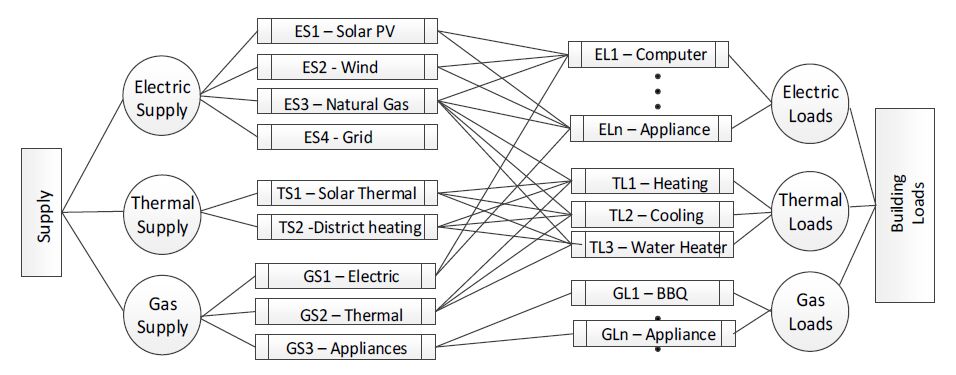
 DownLoad:
DownLoad: 